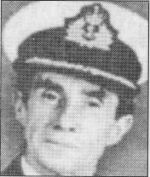- Author
- Newspaper, Sydney Morning Herald
- Subjects
- Biographies and personal histories, Obituaries
- Tags
-
- RAN Ships
- None noted.
- Publication
- March 1999 edition of the Naval Historical Review (all rights reserved)
James Fahey, AM, RAN Commander, 1924-1998

Known throughout the Royal Australian Navy and the veterans’ community as “Curley”, Commander James Anthony Fahey has died at the age of 74. His death has left a void that will be extremely difficult to fill in the counselling of former service personnel and their widows and families.
Fahey had great concern for the rights and welfare of returned and retiring servicemen and women and worked tirelessly on their behalf. His care and compassion were a byword in ex-service organisations.
For several years his health had been failing, but that didn’t stop him carrying on his heavy schedule of work for the ex-service community almost until the final admission to hospital, which ended in his death from secondary cancer a few weeks later. His funeral, in the Dockyard Chapel, Garden Island, was attended by a throng of friends and admirers from the RAN and the wider veterans’ community.
Fahey was born in Randwick and was still a boy when his family moved to Melbourne. He went to secondary school at St Joseph’s College, Abbotsford, an academy noted for its strict adherence to the disciplines of learning. It was not a finishing school for the weak-kneed or faint-hearted.
In January 1943, shortly after his 18th birthday, he joined the RAN as a stoker and because he had training in fitting and turning, passed a trade test to become an engine room artificer. He served in the New Guinea/South-West Pacific theatre, first in HMAS Wagga for two years and then in HMAS Diamantina. It was in this ship that he was present at the Japanese surrenders at Torokina, Nauru and Ocean Island.
Fahey remained in the RAN after the war and was almost continuously at sea until 1953. He served in the Korean War in HMAS Anzac, after which he underwent specialist aircraft catapult training, and subsequently served in the aircraft carriers HMAS Vengeance and HMAS Melbourne. He completed three tours in the Far East Strategic Reserve in the latter ship.
In 1955 he was promoted to commissioned engineer and worked his way through the junior officer ranks in a wide variety of both sea and shore postings. His analytical and inquiring mind led to positions with the fleet engineering staff, conducting inspections and working on refit planning in the dockyard.
In 1975 he was made AM – he took pride in being honoured in the first list of Order of Australia awards – and in 1976 was promoted to commander.
He retired from the Navy in 1979 after 37 years’ service and joined the Repatriation Commission, where he worked for five years in pensions and related matters before retiring a second time, only to volunteer for the Regular Defence Force Welfare Association.
Fahey was able to use his knowledge and expertise in pensions and entitlements to help his fellow servicemen and their families. He had such a total grasp of repatriation law and regulations that his advice was sought on all kinds of questions by the family of ex-service organisations.
His death leaves unfinished one project on which he had worked long and hard; he had campaigned for the Federal Government to reverse its decision not to grant full repatriation benefits for Far East Strategic Reserve Service. Fahey felt that Canberra’s decision not to grant the RAN equality with the Army and the RAAF was shameful and inexplicable.
He married, in 1950, Nola Joyce Cook, who survives him, as does his daughter, Susan.
(Courtesy “S.M.H. “,.13/11/94)




